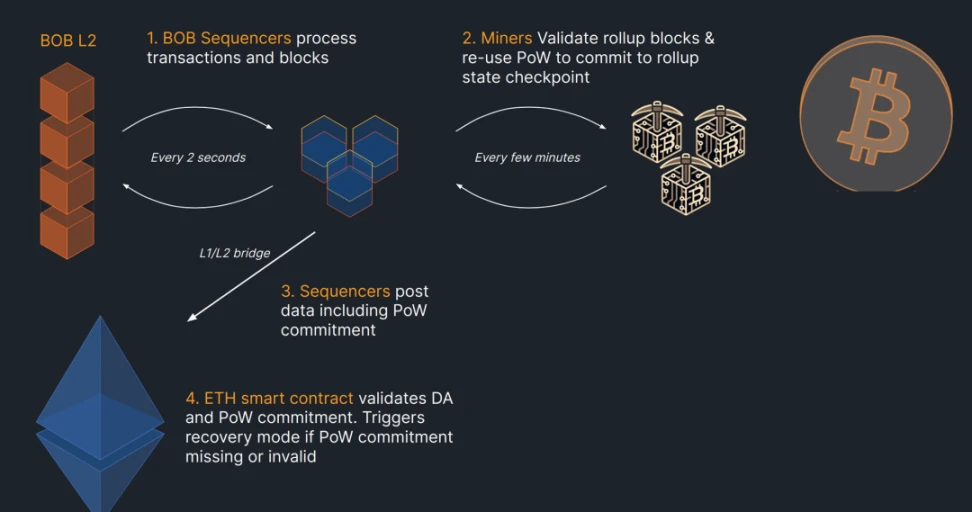Original author: dt
With the arrival of Bitcoin mining reward halving, this round of bull market was initiated by the BTC ETF narrative and ushered in a wave of correction due to the upcoming BTC halving. Now the BTC ecological landscape is very different from that of half a year ago. VC institutions are actively involved. In addition to the community-driven fair launch meme inscription main project, there are also many public chain projects such as BTC L2 or re-staking chain led by venture capital institutions or exchanges.
This week, in CryptoSnap Dr.DODO, we will introduce you to the five most popular BTC-related public chains and the capital support behind them.
BounceBit
BounceBit is a company that uses the value of BTC as the basis of its security and claims to expand the use cases of Bitcoin through its Restaking mechanism. It recently announced that its token $BB will be listed on Binance Web3 wallet token issuance platform Megadrop. BounceBit has become increasingly popular after receiving public investment from BinanceLab. Now it has announced that the token will cooperate with Binance Web3 wallet. $BB has become one of the few new BTC projects launched by Binance recently, attracting more users and funds.
BounceBit is different from other BTC L2s. With the security of Bitcoin chain technology, BounceBit focuses on building an independent POS public chain based on the value of BTC. Through cooperation with CeFi asset management institutions, it uses fee arbitrage and other forms to allow users to obtain an additional layer of income for their custodial BTC. The $BBTC certificates obtained by users’ pledge can be used to run BounceBit Chain nodes or obtain $BB token rewards in the form of LST protocol. In addition, the introduced Restaking mechanism allows other applications in the BounceBit ecosystem to rely on the $BBTC in the nodes to complete other verification tasks such as oracles, cross-chain bridges and other applications.
Currently, BounceBit is still implementing a points program for users to deposit wBTC, BTCB and other assets to earn points, and stated that this will continue until the start of the Metadrop.

Source: https://www.binance.com/zh-CN/research/projects/bouncebit
Merlin Chain
Merlin Chain is the project with the highest TVL among the five projects introduced today, which has now exceeded 950M USD. It is also the first to launch the BTC EVM L2 mainnet. Its token $MERL has also been listed on leading exchanges such as OKX and Bybit recently following the Bitcoin halving event.
Merlin Chain is invested by The Sparta Group and OKX Ventures and other institutions. It is a Layer 2 solution built on Bitcoin. It uses two parallel architectures, OP-Rollup and ZK-Rollup, and calls it optimistic ZK-Rollup. It introduces a decentralized oracle network (Oracle) under the chain as a DAC (Data Availability Committee) to solve the data availability problem. Specifically, Merlins sorter sends transaction data to Oracle nodes and Prover nodes (using Lumozs Prover as a Service). Oracle nodes are responsible for verifying ZK Proof and publishing the verification results to the Bitcoin chain (ZK-Rollup). At the same time, since ZK Proof cannot be fully verified on the Bitcoin chain, a fraud proof mechanism is introduced to allow others to challenge the verification process with fraud proofs (OP-Rollup) to ensure the security of the network.

Source: https://docs.merlinchain.io/merlin-docs/architecture
Merlins ecological project is also the best developed among the current BTC L2. Among them, the asset management agreement Solv Funds, the lending agreement Avalon Finance and the DEX agreement MerlinSwap TVL have all exceeded the 100M threshold. However, after the successful issuance of $MERL, whether there will be more airdrop hunters who will take the funds and move them elsewhere requires continued attention.

Source: https://defillama.com/chain/Merlin
B² Network
B² Network is also a BTC EVM Layer 2 project, invested by Hashkey Captial, OKX Ventures and Kucoin Lab. In terms of technical architecture, B² Network is similar to Merlin Chain in that both adopt the optimistic ZK-Rollup that runs in parallel with ZK-Rollup and OP-Rollup. It also cooperates with Polygon Lab to adopt the zkEVM solution to expand Polygon CDK to BTC, and through account abstraction, users can use both EVM wallet accounts and BTC wallet accounts to interact, while taking care of users with ecological habits on both sides. At the same time, since BTC cannot store large data, B² Network has established a DA Layer B² Node and plans to upgrade B² Node to B² Hub in the future, providing other developers with a data availability layer and status verification/proof system based on the Bitcoin network, enabling them to use Polygon CDK and B² Hub to build their own Bitcoin Rollup.
The biggest difference between B² Network and other BTC Layer 2 is that its vision is not limited to a BTC Layer 2, but has the same ambition as Cosmos Hub or Op Stack to become the BTC second-layer center through B² Hub.

Source: https://docs.bsquared.network/architecture
Currently, B² Network has also launched its mainnet at the same time as BTC halving. The first phase of the locked-up airdrop activity has ended, and the second phase of random airdrops is in progress. As long as users bridge BTC to the B² Network mainnet, they will have the opportunity to receive airdrops when the protocol token is released. There is no clear time limit for this activity, and the official only states that it can end at any time.
BOB
BOB (Build On Bitcoin) is also a BTC EVM Layer 2 project invested by Castle Island, Coinbase Ventures and other institutions, and raised $10 million in the seed round.
In BOBs roadmap, BOB divides its technology into three stages. In the first stage, BOD L2 will use OP Stack to launch the mainnet in the form of Ethereum OP Rollup. Settlement will occur in Ethereum and track the Bitcoin status through Bitcoin light nodes. It verifies block headers and accepts transaction inclusion proofs to achieve trustless cross-chain operations.

Source: https://docs.gobob.xyz/docs/learn/bob-stack/roadmap
The second phase will introduce Bitcoin PoW security using a new merged mining protocol, OptiMine, to separate block production from PoW. After the BOB sorter processes transactions and blocks, Bitcoin miners will verify the BOB Rollup status. Only when the state transition is correct will the miner include the commitment as part of PoW, minimizing trust in the sorter. Finally, the sorter submits data covering the PoW commitment to Ethereum, using Ethereum as the DA Layer to verify data availability.

Source: https://docs.gobob.xyz/docs/learn/bob-stack/roadmap
Bitcoin will be introduced as a settlement layer in the third phase. BOB’s goal is to introduce Bitcoin as a settlement layer (currently under research). A possible solution is to introduce ZK compression as part of the proofing process, cooperate with ZK infrastructure providers, design the BOB light client, build a two-way bridge, and expand the BitVM program to ultimately achieve BOB Rollup state verification.
These three stages show the development path of BOB from the initial optimistic Ethereum Rollup, to the introduction of Bitcoin PoW security, and finally to Bitcoin as the settlement layer. Through this progressive hybrid design, BOB aims to inherit the security of Bitcoin and the programmability of Ethereum, providing an innovative Layer-2 solution for the Bitcoin DeFi ecosystem.

Source: Source: https://docs.gobob.xyz/docs/learn/bob-stack/roadmap
Currently, BOB is carrying out the first season points activity. Depositing tBTC, WBTC or stablecoins and tokens such as ETH LST can earn points rewards. However, with the implementation of the halving event, the official announced that the mainnet will be launched on April 24. At that time, the first season activities will be stopped and the second season points activities will begin. The details have not yet been disclosed.
Mezo
Mezo, which recently announced a $21M funding round led by Pantera Capital and participated by top venture capital firms such as Multicoin and Hack VC, is a new Bitcoin public chain developed by the Thesis team, which created the BTC wrapped asset tBTC. They describe themselves as the economic layer of Bitcoin and will be committed to creating an application ecosystem based on the economic needs of users, focusing on expanding BTC application scenarios. They call their consensus mechanism Proof of HODL, which protects the network by having users lock up BTC and MEZO tokens and execute CometBFT consensus verification transactions.
Similarly, Mezo is also running a HODL points campaign, allowing users to deposit native BTC, WBTC or tBTC to earn points. Currently, Mezo has not disclosed many technical details. All deposits in Mezo are stored in a locked contract, which is controlled by the team to hold funds until the bridge is launched when the Mezo mainnet is launched.

Source: https://info.mezo.org/proof-of-hodl
Authors opinion
The public chain narrative will always be the track with the grandest narrative, the highest valuation and the most financing in the blockchain ecosystem. Therefore, many institutions are unwilling to miss this bull market of Bitcoin narrative and have launched various public chain projects linked to the concept of Bitcoin. In reality, does Bitcoin really need these L2s? Or to put it another way, do currency users care whether the underlying chain they use is BTC or EVM?
From the authors point of view, these BTC-related public chain tracks are more important than how the technical logic behind them is realized. What is more important is the injection of resources behind them. It is a market where various institutions compete for capital. For retail investors, it is just a new chain, and the targets of speculation are nothing more than MEME, DEX, or lending mining.
Therefore, as far as I am concerned, more ways to participate may be to judge the value of the capital behind each project and participate in activities such as airdrop lock-up points in advance to obtain free tokens. Apart from this, at most, after the mainnet is launched, pay attention to whether there are leading Memecoins or whether there are officially endorsed Memes.










